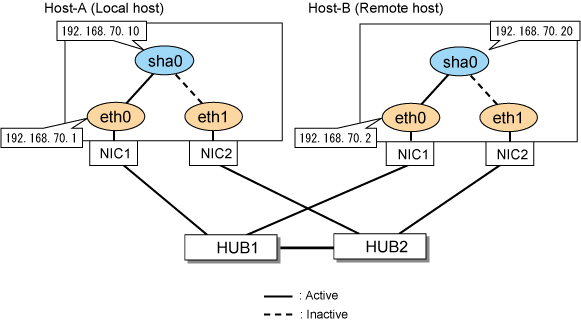This section describes an example configuration procedure of the network shown in the diagram below.

[HOST-A]
1) Setting up the system
Configure /etc/sysconfig/network-scripts/ifcfg-ethX (X is 0, 1) file as follows.
For RHEL8
Contents of /etc/sysconfig/network-scripts/ifcfg-eth0
TYPE=Ethernet BOOTPROTO=none IPADDR=192.168.70.1 PREFIX=24 DEVICE=eth0 ONBOOT=yes |
Contents of /etc/sysconfig/network-scripts/ifcfg-eth1
TYPE=Ethernet BOOTPROTO=none IPADDR=192.168.70.1 PREFIX=24 DEVICE=eth1 ONBOOT=no |
For RHEL9
Set the IP address defined above with the "nmcli connection modify" command.
Configuration of eth0
Set the following parameters with the "nmcli connection modify" command.
ipv4.method:"manual" ipv4.addresses:"192.168.70.1/24" connection.autoconnect:"yes" |
Configuration of eth1
Set the following parameters with the "nmcli connection modify" command.
ipv4.method:"manual" ipv4.addresses:"192.168.70.1/24" connection.autoconnect:"no" |
After setting, verify that the following parameters are set for ethX with the nmcli connection show command. If the parameters are different, fix the settings seeing "3.2.2.1 Setup common to modes."
connection.type:"802-3-ethernet" connection.id: "ethX" connection.interface-name:"ethX" |
2) Reflecting system setting
Run the following command and reload the connection profile. After reloading the profile, verify eth0 is enabled using the ip command.
/usr/bin/nmcli connection reload
3) Setting a subnet mask
/opt/FJSVhanet/usr/sbin/hanetmask create -i 192.168.70.0 -m 255.255.255.0
4) Creating a virtual interface
/opt/FJSVhanet/usr/sbin/hanetconfig create -n sha0 -m d -i 192.168.70.10 -e 192.168.70.1 -t eth0,eth1
5) Setting up the HUB monitoring function
/opt/FJSVhanet/usr/sbin/hanetpoll create -n sha0 -p _none_
6) Reboot
Run the following command to reboot the system.
/sbin/shutdown -r now
[HOST-B]
1) Setting up the system
Configure /etc/sysconfig/network-scripts/ifcfg-ethX (X is 0, 1) file as follows.
For RHEL8
Contents of /etc/sysconfig/network-scripts/ifcfg-eth0
TYPE=Ethernet BOOTPROTO=none IPADDR=192.168.70.2 PREFIX=24 DEVICE=eth0 ONBOOT=yes |
Contents of /etc/sysconfig/network-scripts/ifcfg-eth1
TYPE=Ethernet BOOTPROTO=none IPADDR=192.168.70.2 PREFIX=24 DEVICE=eth1 ONBOOT=no |
For RHEL9
Set the IP address defined above with the "nmcli connection modify" command.
Configuration of eth0
Set the following parameters with the "nmcli connection modify" command.
ipv4.method:"manual" ipv4.addresses:"192.168.70.2/24" connection.autoconnect:"yes" |
Configuration of eth1
Set the following parameters with the "nmcli connection modify" command.
ipv4.method:"manual" ipv4.addresses:"192.168.70.2/24" connection.autoconnect:"no" |
After setting, verify that the following parameters are set for ethX with the nmcli connection show command. If the parameters are different, fix the settings seeing "3.2.2.1 Setup common to modes."
connection.type:"802-3-ethernet" connection.id: "ethX" connection.interface-name:"ethX" |
2) Reflecting system setting
Run the following command and reload the connection profile. After reloading the profile, verify eth0 is enabled using the ip command.
/usr/bin/nmcli connection reload
3) Setting a subnet mask
/opt/FJSVhanet/usr/sbin/hanetmask create -i 192.168.70.0 -m 255.255.255.0
4) Creating a virtual interface
/opt/FJSVhanet/usr/sbin/hanetconfig create -n sha0 -m d -i 192.168.70.20 -e 192.168.70.2 -t eth0,eth1
5) Setting up the HUB monitoring function
/opt/FJSVhanet/usr/sbin/hanetpoll create -n sha0 -p _none_
6) Reboot
Run the following command to reboot the system.
/sbin/shutdown -r now